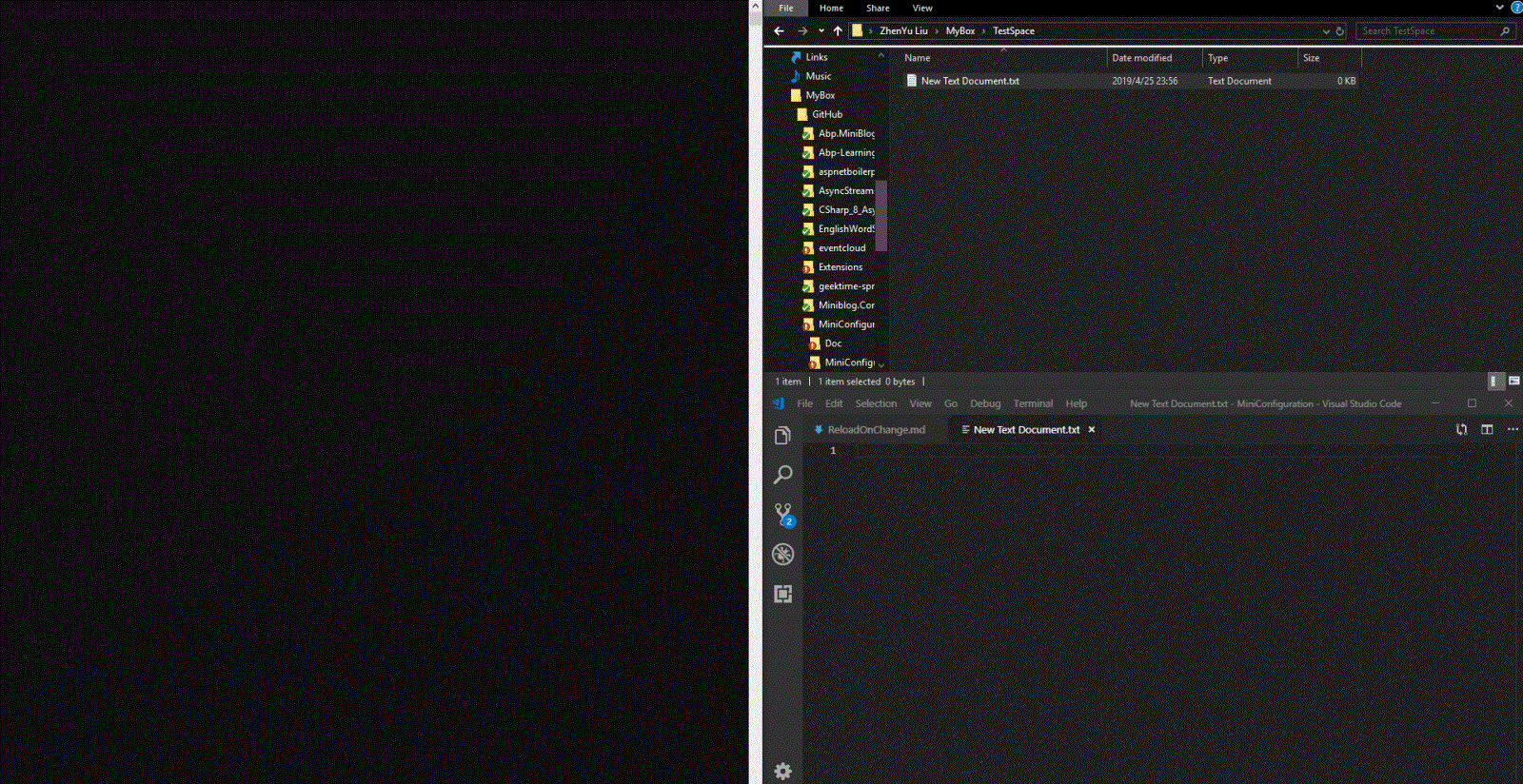Pre
很早在看 Jesse 的 Asp.net Core快速入门 的课程的时候就了解到了在Asp .net core中,如果添加的Json配置被更改了,是支持自动重载配置的,作为一名有着严重"造轮子"情节的程序员,最近在折腾一个博客系统,也想造出一个这样能自动更新以Mysql为数据源的ConfigureSource,于是点开了AddJsonFile这个拓展函数的源码,发现别有洞天,蛮有意思,本篇文章就简单地聊一聊Json config的ReloadOnChange是如何实现的,在学习ReloadOnChange的过程中,我们会把Configuration也顺带撩一把:grin:,希望对小伙伴们有所帮助.
|
1
2
3
4
5
6
7
|
public static IWebHostBuilder CreateWebHostBuilder(string[] args) => WebHost.CreateDefaultBuilder(args) .ConfigureAppConfiguration(option => { option.AddJsonFile("appsettings.json",optional:true,reloadOnChange:true); }) .UseStartup<Startup>(); |
在Asp .net core中如果配置了json数据源,把reloadOnChange属性设置为true即可实现当文件变更时自动更新配置,这篇博客我们首先从它的源码简单看一下,看完你可能还是会有点懵的,别慌,我会对这些代码进行精简,做个简单的小例子,希望能对你有所帮助.
一窥源码
AddJson
首先,我们当然是从这个我们耳熟能详的扩展函数开始,它经历的演变过程如下.
|
1
2
3
4
|
public static IConfigurationBuilder AddJsonFile(this IConfigurationBuilder builder,string path,bool optional,bool reloadOnChange){return builder.AddJsonFile((IFileProvider) null, path, optional, reloadOnChange);} |
传递一个null的FileProvider给另外一个重载Addjson函数.
敲黑板,Null的FileProvider很重要,后面要考:smile:.
|
1
2
3
4
5
6
7
8
9
10
11
|
public static IConfigurationBuilder AddJsonFile(this IConfigurationBuilder builder,IFileProvider provider,string path,bool optional,bool reloadOnChange){ return builder.AddJsonFile((Action<JsonConfigurationSource>) (s => { s.FileProvider = provider; s.Path = path; s.Optional = optional; s.ReloadOnChange = reloadOnChange; s.ResolveFileProvider(); }));} |
把传入的参数演变成一个Action委托给 JsonConfigurationSource 的属性赋值.
|
1
2
3
4
|
public static IConfigurationBuilder AddJsonFile(this IConfigurationBuilder builder, Action<JsonConfigurationSource> configureSource){ return builder.Add<JsonConfigurationSource>(configureSource);} |
最终调用的builder.add
|
1
2
3
4
5
6
7
|
public static IConfigurationBuilder Add<TSource>(this IConfigurationBuilder builder,Action<TSource> configureSource)where TSource : IConfigurationSource, new(){ TSource source = new TSource(); if (configureSource != null) configureSource(source); return builder.Add((IConfigurationSource) source);} |
在Add方法里,创建了一个Source实例,也就是JsonConfigurationSource实例,然后把这个实例传为刚刚的委托,这样一来,我们在最外面传入的 "appsettings.json",optional:true,reloadOnChange:true 参数就作用到这个示例上了.
最终,这个实例添加到builder中.那么builder又是什么?它能干什么?
ConfigurationBuild
前面提及的builder默认情况下是 ConfigurationBuilder ,我对它的进行了简化,关键代码如下.
|
1
2
3
4
5
6
7
8
9
10
11
12
13
14
15
16
17
18
19
20
21
|
public class ConfigurationBuilder : IConfigurationBuilder { public IList<IConfigurationSource> Sources { get; } = new List<IConfigurationSource>(); public IConfigurationBuilder Add(IConfigurationSource source) { Sources.Add(source); return this; } public IConfigurationRoot Build() { var providers = new List<IConfigurationProvider>(); foreach (var source in Sources) { var provider = source.Build(this); providers.Add(provider); } return new ConfigurationRoot(providers); } } |
可以看到,这个builder中有个集合类型的Sources,这个Sources可以保存任何实现了 IConfigurationSource 的Source,前面聊到的 JsonConfigurationSource 就是实现了这个接口,常用的还有 MemoryConfigurationSource , XmlConfigureSource , CommandLineConfigurationSource 等.
另外,它有一个很重要的build方法,这个build方法在 WebHostBuilder 方法执行 build 的时候也被调用,不要问我 WebHostBuilder.builder 方法什么执行的:joy:.
|
1
2
3
4
|
public static void Main(string[] args) { CreateWebHostBuilder(args).Build().Run(); } |
在ConfigureBuilder的方法里面就调用了每个Source的Builder方法,我们刚刚传入的是一个 JsonConfigurationSource ,所以我们有必要看看JsonSource的builder做了什么.
这里是不是被这些builder绕哭了? 别慌,下一篇文章中我会讲解如何自定义一个ConfigureSoure,会把Congigure系列类UML类图整理一下,应该会清晰很多.
JsonConfigurationSource
|
1
2
3
4
5
6
7
8
|
public class JsonConfigurationSource : FileConfigurationSource { public override IConfigurationProvider Build(IConfigurationBuilder builder) { EnsureDefaults(builder); return new JsonConfigurationProvider(this); } } |
这就是 JsonConfigurationSource 的所有代码,未精简,它只实现了一个Build方法,在Build内,EnsureDefaults被调用,可别小看它,之前那个空的FileProvider在这里被赋值了.
|
1
2
3
4
5
6
7
8
|
public void EnsureDefaults(IConfigurationBuilder builder) { FileProvider = FileProvider ?? builder.GetFileProvider(); } public static IFileProvider GetFileProvider(this IConfigurationBuilder builder) { return new PhysicalFileProvider(AppContext.BaseDirectory ?? string.Empty); } |
可以看到这个FileProvider默认情况下就是 PhysicalFileProvider ,为什么对这个 FileProvider 如此宠幸让我花如此大的伏笔要强调它呢?往下看.
JsonConfigurationProvider && FileConfigurationProvider
在JsonConfigurationSource的build方法内,返回的是一个JsonConfigurationProvider实例,所以直觉告诉我,在它的构造函数内必有猫腻:confused:.
|
1
2
3
4
5
6
7
8
9
10
11
12
13
14
15
16
|
public class JsonConfigurationProvider : FileConfigurationProvider{ public JsonConfigurationProvider(JsonConfigurationSource source) : base(source) { } public override void Load(Stream stream) { try { Data = JsonConfigurationFileParser.Parse(stream); } catch (JsonReaderException e) { throw new FormatException(Resources.Error_JSONParseError, e); } }} |
看不出什么的代码,事出反常必有妖~~
看看base的构造函数.
|
1
2
3
4
5
6
7
8
9
10
11
12
13
14
|
public FileConfigurationProvider(FileConfigurationSource source) { Source = source; if (Source.ReloadOnChange && Source.FileProvider != null) { _changeTokenRegistration = ChangeToken.OnChange( () => Source.FileProvider.Watch(Source.Path), () => { Thread.Sleep(Source.ReloadDelay); Load(reload: true); }); } } |
真是个天才,问题就在这个构造函数里,它构造函数调用了一个 ChangeToken.OnChange 方法,这是实现ReloadOnChange的关键,如果你点到这里还没有关掉,恭喜,好戏开始了.
ReloadOnChange
Talk is cheap. Show me the code (屁话少说,放 码 过来).
|
1
2
3
4
5
6
7
|
public static class ChangeToken{ public static ChangeTokenRegistration<Action> OnChange(Func<IChangeToken> changeTokenProducer, Action changeTokenConsumer) { return new ChangeTokenRegistration<Action>(changeTokenProducer, callback => callback(), changeTokenConsumer); }} |
OnChange方法里,先不管什么func,action,就看看这两个参数的名称,producer,consumer,生产者,消费者,不知道看到这个关键词想到的是什么,反正我想到的是小学时学习食物链时的:snake:与:rat:.
那么我们来看看这里的:snake:是什么,:rat:又是什么,还得回到 FileConfigurationProvider 的构造函数.
可以看到生产者:rat:是:
|
1
|
() => Source.FileProvider.Watch(Source.Path) |
消费者:snake:是:
|
1
2
3
4
|
() => { Thread.Sleep(Source.ReloadDelay); Load(reload: true);} |
我们想一下,一旦有一条:rat:跑出来,就立马被:snake:吃了,
那我们这里也一样,一旦有FileProvider.Watch返回了什么东西,就会发生Load()事件来重新加载数据.
:snake:与:rat:好理解,可是代码就没那么好理解了,我们通过 OnChange 的第一个参数 Func<IChangeToken> changeTokenProducer 方法知道,这里的:rat:,其实是 IChangeToken .
IChangeToken
|
1
2
3
4
5
6
7
8
|
public interface IChangeToken{ bool HasChanged { get; } bool ActiveChangeCallbacks { get; } IDisposable RegisterChangeCallback(Action<object> callback, object state);} |
IChangeToken的重点在于里面有个RegisterChangeCallback方法,:snake:吃:rat:的这件事,就发生在这回调方法里面.
我们来做个:snake:吃:rat:的实验.
实验1
|
1
2
3
4
5
6
7
8
9
10
11
12
13
14
15
16
17
18
19
20
21
22
23
|
static void Main() { //定义一个C:\Users\liuzh\MyBox\TestSpace目录的FileProvider var phyFileProvider = new PhysicalFileProvider("C:\\Users\\liuzh\\MyBox\\TestSpace"); //让这个Provider开始监听这个目录下的所有文件 var changeToken = phyFileProvider.Watch("*.*"); //注册🐍吃🐀这件事到回调函数 changeToken.RegisterChangeCallback(_=> { Console.WriteLine("老鼠被蛇吃"); }, new object()); //添加一个文件到目录 AddFileToPath(); Console.ReadKey(); } static void AddFileToPath() { Console.WriteLine("老鼠出洞了"); File.Create("C:\\Users\\liuzh\\MyBox\\TestSpace\\老鼠出洞了.txt").Dispose(); } |
这是运行结果

可以看到,一旦在监听的目录下创建文件,立即触发了执行回调函数,但是如果我们继续手动地更改(复制)监听目录中的文件,回调函数就不再执行了.
这是因为changeToken监听到文件变更并触发回调函数后,这个changeToken的使命也就完成了,要想保持一直监听,那么我们就在在回调函数中重新获取token,并给新的token的回调函数注册通用的事件,这样就能保持一直监听下去了.
这也就是ChangeToken.Onchange所作的事情,我们看一下源码.
|
1
2
3
4
5
6
7
8
9
10
11
12
13
14
15
16
17
18
19
20
21
22
23
24
25
26
27
28
29
30
31
32
33
34
35
36
37
38
39
40
41
42
43
44
|
public static class ChangeToken{ public static ChangeTokenRegistration<Action> OnChange(Func<IChangeToken> changeTokenProducer, Action changeTokenConsumer) { return new ChangeTokenRegistration<Action>(changeTokenProducer, callback => callback(), changeTokenConsumer); }}public class ChangeTokenRegistration<TAction>{ private readonly Func<IChangeToken> _changeTokenProducer; private readonly Action<TAction> _changeTokenConsumer; private readonly TAction _state; public ChangeTokenRegistration(Func<IChangeToken> changeTokenProducer, Action<TAction> changeTokenConsumer, TAction state) { _changeTokenProducer = changeTokenProducer; _changeTokenConsumer = changeTokenConsumer; _state = state; var token = changeTokenProducer(); RegisterChangeTokenCallback(token); } private void RegisterChangeTokenCallback(IChangeToken token) { token.RegisterChangeCallback(_ => OnChangeTokenFired(), this); } private void OnChangeTokenFired() { var token = _changeTokenProducer(); try { _changeTokenConsumer(_state); } finally { // We always want to ensure the callback is registered RegisterChangeTokenCallback(token); } }} |
简单来说,就是给token注册了一个 OnChangeTokenFired 的回调函数,仔细看看 OnChangeTokenFired 里做了什么,总体来说三步.
1.获取一个新的token.
2.调用消费者进行消费.
3.给新获取的token再次注册一个OnChangeTokenFired的回调函数.
如此周而复始~~
实验2
既然知道了OnChange的工作方式,那么我们把实验1的代码修改一下.
|
1
2
3
4
5
6
7
|
static void Main(){ var phyFileProvider = new PhysicalFileProvider("C:\\Users\\liuzh\\MyBox\\TestSpace"); ChangeToken.OnChange(() => phyFileProvider.Watch("*.*"), () => { Console.WriteLine("老鼠被蛇吃"); }); Console.ReadKey();} |
执行效果看一下

可以看到,只要被监控的目录发生了文件变化,不管是新建文件,还是修改了文件内的内容,都会触发回调函数,其实JsonConfig中,这个回调函数就是Load(),它负责重新加载数据,可也就是为什么Asp .net core中如果把ReloadOnchang设置为true后,Json的配置一旦更新,配置就会自动重载.
PhysicalFilesWatcher
那么,为什么文件一旦变化,就会触发ChangeToken的回调函数呢? 其实 PhysicalFileProvider 中调用了 PhysicalFilesWatcher 对文件系统进行监视,观察PhysicalFilesWatcher的构造函数,可以看到 PhysicalFilesWatcher 需要传入 FileSystemWatcher , FileSystemWatcher 是 system.io 下的底层IO类,在构造函数中给这个Watcher的Created,Changed,Renamed,Deleted注册EventHandler事件,最终,在这些EventHandler中会调用ChangToken的回调函数,所以文件系统一旦发生变更就会触发回调函数.
|
1
2
3
4
5
6
7
8
9
10
11
12
13
14
15
|
public PhysicalFilesWatcher(string root,FileSystemWatcher fileSystemWatcher,bool pollForChanges,ExclusionFilters filters){ this._root = root; this._fileWatcher = fileSystemWatcher; this._fileWatcher.IncludeSubdirectories = true; this._fileWatcher.Created += new FileSystemEventHandler(this.OnChanged); this._fileWatcher.Changed += new FileSystemEventHandler(this.OnChanged); this._fileWatcher.Renamed += new RenamedEventHandler(this.OnRenamed); this._fileWatcher.Deleted += new FileSystemEventHandler(this.OnChanged); this._fileWatcher.Error += new ErrorEventHandler(this.OnError); this.PollForChanges = pollForChanges; this._filters = filters; this.PollingChangeTokens = new ConcurrentDictionary<IPollingChangeToken, IPollingChangeToken>(); this._timerFactory = (Func<Timer>) (() => NonCapturingTimer.Create(new TimerCallback(PhysicalFilesWatcher.RaiseChangeEvents), (object) this.PollingChangeTokens, TimeSpan.Zero, PhysicalFilesWatcher.DefaultPollingInterval));} |
如果你和我一样,对源码感兴趣,可以从官方的 aspnet/Extensions 中下载源码研究: https://github.com/aspnet/Extensions
在下一篇文章中,我会讲解如何自定义一个以Mysql为数据源的ConfigureSoure,并实现自动更新功能,同时还会整理Configure相关类的UML类图,有兴趣的可以关注我以便第一时间收到下篇文章.
本文章涉及的代码地址: https://github.com/liuzhenyulive/MiniConfiguration
以上就是本文的全部内容,希望对大家的学习有所帮助,也希望大家多多支持服务器之家。
原文链接:http://www.cnblogs.com/CoderAyu/p/10776845.html












